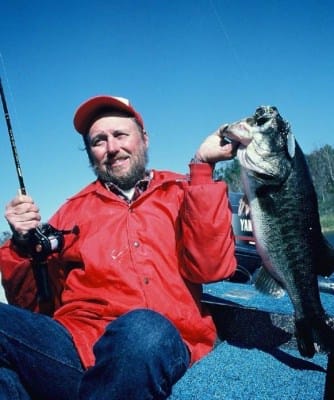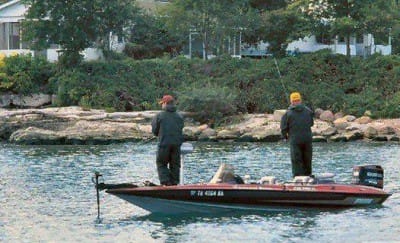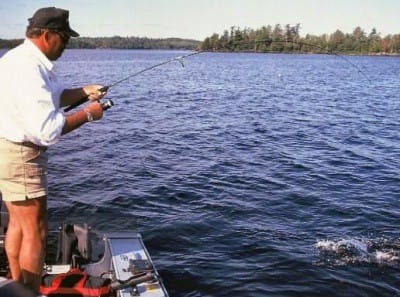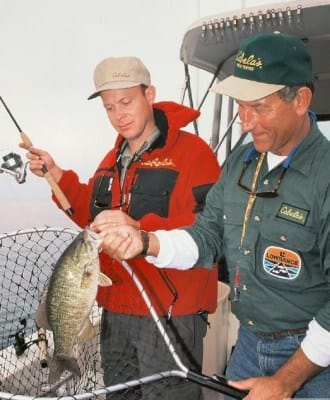Submitted By:
Bob McNally – USA Guest Author
 Pat Chrysler slowed his 30-foot bass boat 200 yards from a deep, rocky point in the Bass Islands area of sprawling Lake Erie, Ohio, allowing the heavy cabin cruiser to glide gently into casting position. He then watched his fathometer with the intensity all skilled deep-water bass anglers have for interpreting bottom structure.
Pat Chrysler slowed his 30-foot bass boat 200 yards from a deep, rocky point in the Bass Islands area of sprawling Lake Erie, Ohio, allowing the heavy cabin cruiser to glide gently into casting position. He then watched his fathometer with the intensity all skilled deep-water bass anglers have for interpreting bottom structure.
Chrysler’s fishing tactic was a simple one: drift across a structure and fan cast lures on and around the point, working them slowly and methodically near bottom. If he found a spot where bass were concentrated, he’d toss over a floating marker, and carefully work the area. If no cooperative fish were found, he’d move to another rocky point.
The tactic worked well for two hours, and Nebraska friend Tom Rosdail and I boated several dozen bronzebacks to 3 pounds fishing that way. Most were caught tight to the bottom, near subtle drops in depth that Chrysler pinpointed with his big boat fathometer, and we tricked the fish into hitting Berkley “Gulp” grubs and Cabela’s spinner-baits (perch colored). Then the Lake Erie wind came up, and Chrysler was forced to employ a boat control tactic out of yesteryear’s fishing play book—-anchoring!

Unlike many modern bass anglers Chrysler uses a 30-foot boat for his fishing, because Erie is rough and cold, and the boat is a comfortable, practical fishing platform in any kind of weather. But it’s not the size boat easily pulled around with an electric motor.
Because he uses a big boat, often in gusty wind, Chrysler has become expert at controlling his fishing platform by anchoring it. Once he discovers a likely bass spot, he tosses over a floating marker, then motors 100 to 150 yards upwind. Next a heavy anchor is dropped, then Chrysler lets out just enough anchor line that his boat holds on the upwind edge of the structure—-just within casting range of the floating marker, so as not to spook bass in the martini-clear waters of Lake Erie.
Chrysler instructs his anglers to lower their lures to bottom, or cast. If no fish strike, Chrysler uses his anchoring magic to pinpoint smallmouths. Periodically he lets out 10 to 20 feet of anchor rope so his boat drifts with the wind, and anglers are then working a different part of the structure. No fish, more anchor line—-different structure areas probed. He merely turns the boat wheel to port or starboard to make the boat “swing” in wind on the anchor line to probe places on a structure far left or right. Fishing this way, while occasionally letting out more anchor line, Chrysler thoroughly and quietly probes an entire bass bar or reef, and effectively taps virtually every suitable place a fish could reside.
This is the kind of precision boat control guides like Chrysler must use to consistently put clients on big-water, big-structure bass. If more average bass anglers “went to school” on Chrysler’s techniques, anchoring when the need arises, there’s no question they’d catch more and bigger bass—-especially when the wind is up and bass are down.
But anchoring isn’t the only way bass anglers can deal effectively with handling a boat in strong wind.

Trolling With a Tiller Handle
One August, for example, on eastern Ontario’s Lake Obabika, friends and I mopped up on smallmouth bass to four pounds by trolling from a tiller-handle, outboard-powered boat.
The wind was from the south, breaking across the bar, and I figured if there were bass on the structure they’d be on the up-wind or south side, feeding on minnows washed against the sand. Nice theory, but I couldn’t hold the boat in position for proper casting with the electric motor, so I fired the big engine for boat control.
I moved the boat out from the bar, and started to troll with deep-going crankbaits. The idea of dragging lures behind the boat didn’t appeal to my fishing partner any more than me. But it made sense to at least have something in the water while I checked deep structure with the fathometer. On the upwind side of the sandbar, starting at 9 feet, the structure dropped off in a series of stair-step ledges. The ledges ran parallel to the sandbar, but they were small and irregular—-forming little cuts and points, a difficult structure to hold the boat in position with an electric motor in a gale wind and effectively cast to each likely bass spot.
While trolling a 12-foot ledge parallel to the sandbar, the depth finder showed the bottom suddenly dropped to 15-, 19-, 25-, 27-feet, then quickly came back up to 12 feet. Over the deepest part of the drop-off the LCD fathometer I had my eyes glued to became almost black as it “marked” small and large fish. Just as I told my buddy about the “marks,” he gave a hoot, and his fishing rod arched.
I stopped the boat and soon Jack had a 2-pound smallmouth near the boat—-followed by several larger bass. I flipped them a crankbait, and we had a doubleheader.
Backtrolling
Trolling in reverse, or “backtrolling,” was developed by Minnesota guides who needed precise boat control to effectively work deep structure contour lines in properly presenting lures and baits to hard-pressured, clear-water fish. Although backtrolling is often associated with walleye fishing, it also is a superb method of boat control for putting lures “on the money” for deep bass.
Backtrolling can be done with either a gas outboard (tiller handle best) or an electric motor. The purpose is precise boat control, with lures (normally jigs or plastic worms) or natural baits fished vertically under the boat, while the person running the boat follows exacting bottom contours (by carefully watching a fathometer).

This style fishing allows anglers to thoroughly probe a deep structure, say a “hump” that tops out at 15 feet, with drop-offs at either end falling to 40 feet. To work such a hump, two anglers would put out lures or baits on opposite sides of a boat. It’s important heavy enough lures are used (or weight with bait) to maintain bottom contact as the boat is under power. Jigs, plastic worms rigged Texas or Carolina style, and Lindy-type sliding sinker rigs for use with live baits are all good choices.
With the boat’s motor in reverse, anglers “troll” very slowly into wind or current, which keeps lines away from the motor propeller. A boat also responds very nimbly when trolled in reverse, which is necessary to keep deep lures in proper position while following sharp turns in depth contour on a structure.
This is systematic, deep fishing, that takes great boat-handling skill and a keen sense of “feel” for strikes, as well as ability to interpret structure configurations shown on a fathometer.
It’s best to begin backtrolling a structure “shallow,” in this case on top of the hump at 15 feet. Work all the 15 foot water, then move slightly deeper to the first drop-off, which may be at 18 feet. Backtroll that depth contour, then move to the next drop-off, which may be at 24 feet, then out to the next, and so on. This systematic, methodical and slow boat control search of depth contours on deep structure is one of the most thorough ways of locating bass, and allows anglers to “map” prime structures unlike any other fishing style.
Proper boat control for bass fishing isn’t rocket science. It’s just common sense boatsmanship that allows anglers to quietly, effectively and efficiently work bass water. But a skilled angler toils hard at proper boat control, because the fisherman controlling the boat is running the show. How and where he puts a boat in position directly affects the way lures and baits are presented to fish, and if bass are duped in the best possible manner.
Wise, then, are bass anglers who handle boats with all the planning and care as they prepare their rods, reels, lures and baits.



